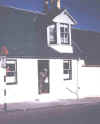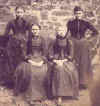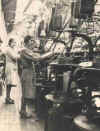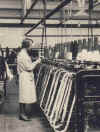Cleughearn
Farm
I'd like to see the old farm just once more,
and my old dog, a sleeping in the shade, beside the
door;
hear the cattle lowing as they come home down the
lane,
and watch an evening sunset o'er a field of waving
grain.
I'd like to see my mother, just once more;
looking as she used to look in days of yore;
I'd like to see my Father as he was when I was
young,
and hear him talk with Mother - in the braid auld
Scottish tongue
I'd like to meet the neighbours that we had long,
long, ago,
to talk of days of Auld Lang Syne, and friends we
used to know;
I wonder why we wander and just what we hope to
find,
to take the place of those we loved in the homes we
left behind."
John Cochrane,
Winnipeg, Canada.
Strathaven
Town Mill
|

A Town Mill was
established on this site, courtesy of the Ducal family of Hamilton, in the 16th
century. And a working mill was continuous there until the 1930s when a new
power house was installed. But by the 1960s the dereliction of the historic Town
Mill had earned it the name of 'Dracula's Castle'. Subsequent restoration, under
the aegis of Strathaven Arts Guild with the financial support of the former East
Kilbride District Council, Manpower Services Commission and charitable
donations, ensured the future of the Town Mill buildings as a centre for the
arts in Strathaven and District. The property came into the ownership of
Strathaven Arts Guild and is now styled the Strathaven Arts Centre. "Better
Canna Be."
|
Weaving in Strathaven
Mrs
Cumming, nee Jean Dalziel at her Spinning Wheel
Jean Dalziel, relict of Robert Cumming, died
at Crofthead, Strathaven, 21st July, 1888 aged 85 years. Of the four girls
pictured above right (all of them weavers) Jean's daughter appears first left back row.
"If it wusnae
for the Weavers' whit wud we dae"
According to the Statistical Account of the Parish of Avondale of 1835
"numbers of weavers in both town and parish may be said to amount to nearly
800 . . . many of the weavers are proprietors of their own houses and upon the
whole are diligent and industrious". By 1938 Handloom weaving in
Strathaven had altogether ceased.
 |
Mr John Anderson at the doorway of his house at
18 Hamilton Road, Flemington, Strathaven that was
once owned by the proprietors of East Overton House whose coachman lived there.
|
A postcard depiction of Handloom Weavers (below) is
postmarked Strathaven 27 March, 1907.
Employees of Frew's Textiles Factory,
Strathaven.
James and Robert Hamilton (father and son)
James
Hamilton, entrepreneur, was remarkable as a textile designer, mill owner and
inventor. His cotton mill remains standing in Chapel Road, Strathaven, behind
what was his domestic dwelling at Ladeside, Lower Ballgreen. James was
essentially a “Designer and Manufacturer of Art Muslin and Tapestry Curtains”.
However, when business declined he sold the mill to enter into partnership with
his sons trading as “Textile Designers and Jacquard Card Cutters”. In keeping
with his progressive ideas James installed a “gas engine” to drive the cutting
machine that stamped out the perforations. From 1878 onwards James patented a
number of loom modifications but, with characteristic generosity, he chose to
bury one invention in his garden ground since it would have resulted in
redundancy for many of Darvel’s lace makers. Such, indeed, were James’
entrepreneurial skills that none other than the renowned Lord Kelvin chose to
seek James’ advice when designing the Kelvin safety coupling for railway
carriages.
Robert
Hamilton, son of James, was born 4th April, 1870 at Commercial Road,
Strathaven. In adult life Robert pursued a wide range of interests that, besides
textile design, included painting and photography. As a true ‘lad o’ pairts’
Robert also excelled in the arts as a painter, photographer, musician, writer,
and in sports as an angler and golfer. Robert was the second son of James
Hamilton whose domestic life centred around the several children of his marriage
to Jeannie Brown. Robert married Elizabeth Cochrane of Main Street, Strathaven.
There were two children of the marriage namely, Willie born 1896, and Katie born
1898, each of whom had a keen interest in music and art. Robert was a skilful
violinist, and a leading cornet player with Strathaven Brass Band. However, golf
was their abiding passion. Katie is especially remembered with affection in the
town, indeed, and her membership of Strathaven Golf Club is commemorated in her
portrait which holds a place of honour within its members room. Willie, who
trained as a commercial artist, gained an L.R.A.M in pianoforte and, thereafter,
focussed on teaching music such that textile design became a part-time pursuit..
Robert
demonstrated his talent for writing by winning a gold and a silver medal in
competitions organised by popular magazines of the day and regularly contributed
short to many periodicals. During the 1920s, for example, he produced a serial
for The People’s Journal recounting the humorous adventures of Rab Gallie “a
modest weaver of Heddletown” (a pseudonym for Strathaven) who following on the
death of his brother Wull in Australia falls heir to the princely sum of
£14,000.
Robert died
at Melbourne Cottage, Glasgow Road, Strathaven in 1925 aged 55 years. His wife
Lizzie lived to the ripe old age of 83. Willie and Katie Hamilton remained in
residence there until their demise.
Pictures
from Robert Hamilton’s collection reproduced by kind permission of Catherine
Cochrane and Sheena Andrew, great-nieces of Robert Hamilton.
Email:- rpc12437@hotmail.com
robert.currie3@btopenworld.com
http://rpc12437.tripod.com
http://strathavenrussianprinces.hostwebs.com/
Back to top










